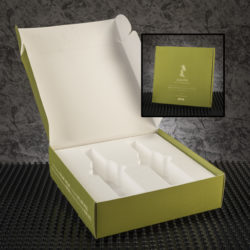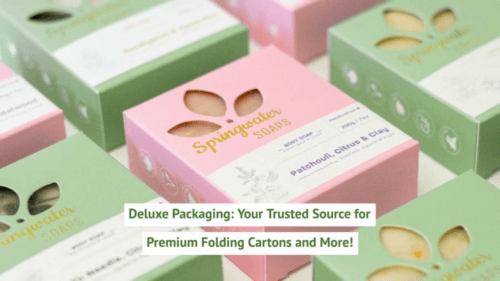Mastering The Art Of The Folding Carton: Your Ultimate Guide To Innovative Packaging Solutions
Custom Packaging ProductsA folding carton is a packaging solution that is cut, folded, and glued to create a three-dimensional structure. It is a versatile and cost-effective option for packaging various goods, from food and beverages to cosmetics and consumer electronics. This type of packaging is used extensively in the retail industry, protecting products during transportation and storage while contributing to brand marketing.
Deluxe Packaging has been a leading provider of premium packaging products, including folding cartons and corrugated boxes, since 1982. Our team will develop and deliver an excellent product packaging solution regardless of your application or industry.
Folding Carton Design Basics
Carefully designing folding cartons is essential to create packaging solutions that properly protect products and captivate consumers on the shelves. Here are some basics to consider:
-
Material Selection
Choosing the right material is critical for achieving the folding carton’s desired look, feel, and functionality. Below are some materials used to create this packaging solution:
- Paperboard: This material is a versatile and popular choice for folding cartons due to its lightweight nature, printability, and recyclability. It offers a smooth surface for vibrant graphics and intricate designs and comes in various grades to suit different product needs. It is commonly used for food, cosmetics, and consumer goods packaging.
- Corrugated board: This option is renowned for its strength and durability, making it ideal for products that require robust protection during transit. It comprises a fluted core sandwiched between two flat liners, offering excellent cushioning and shock absorption. Corrugated board is commonly used for shipping boxes, displays, and heavy-duty packaging.
- Specialty boards: Specialty boards offer unique visual and tactile effects, allowing brands to create premium packaging. They are commonly used for luxury cosmetics, jewelry, and high-end consumer goods.
- Recycled materials: Materials like recycled paperboard are commonly used for eco-friendly packaging solutions and products focusing on sustainability. These are made from post-consumer waste and can be customized with different coatings and finishes to achieve the desired look and feel.
- Biodegradable materials: Biodegradable plastics and plant-based fibers are gaining popularity as sustainable alternatives to traditional packaging materials. They break down naturally in the environment, reducing the waste generated.
-
Structural Design Types and Styles
Structural design refers to the physical construction and layout of the packaging. It determines the form, function, and practicality of the carton. Folding cartons come in various types, each with unique features and applications. Here are some common types:
- Straight tuck end (STE): This is one of the most basic folding carton styles. The top and bottom flaps of the carton tuck into the sides, creating a clean and seamless look. It is commonly used for small consumer goods, cosmetics, and pharmaceuticals.
- Reverse tuck end (RTE): This is similar to STE cartons, except the top and bottom flaps tuck in opposite directions. It is often used for products that require easy access, such as electronics and snacks.
- Seal end (SE): These cartons have one end sealed shut while the other is open for product insertion. SE cartons are commonly used for products that need to be securely sealed, such as food items, DVDs, and software packages.
- Auto-lock bottom (ALB): This option has a pre-glued base that automatically locks into place when the carton is folded. ALB cartons are ideal for products that need to be assembled quickly and efficiently, such as food items, toys, and small appliances.
- Dispenser boxes: These have an opening that dispenses the product, making them ideal for products that need to be easily accessed, such as tissues, wipes, and candy.
- Gable top boxes: These cartons have a unique gable-shaped top that adds visual interest and makes them stand out on the shelf. Gable top boxes are commonly used for food items, such as bakery products and frozen foods.
-
Printing Techniques
Printing techniques are an essential part of the folding carton design process, as they determine the visual appeal and branding of the packaging. Here are some common printing techniques used:
- Offset printing: Also known as lithography, this involves transferring ink from a metal plate to a rubber blanket and then onto the paperboard. Offset printing produces high-quality images and is suitable for large print runs.
- Digital printing: This printing technique uses digital files to print images directly onto the paperboard. It provides high-quality results but may have color accuracy and image resolution limitations. This option is ideal for short print runs and offers quick turnaround times.
- Flexographic printing: This uses flexible relief plates to transfer ink onto the paperboard. It is cost-effective and can produce vibrant colors, but it may have limitations regarding image resolution and detail. Flexographic printing is commonly used for simple designs and large print runs.
- Gravure printing: This option uses engraved cylinders to transfer ink onto the paperboard. It is suitable for high-volume print runs and can achieve high-quality results with precise color reproduction.
- Silkscreen printing: This process involves pressing ink through a fine mesh screen onto the paperboard. It is ideal for printing on uneven surfaces and producing bold, opaque colors.
-
Finishing Touches
Finishing touches are the final details that can elevate the appearance and functionality of a folding carton. Here are some common options used in the packaging industry:
- Embossing and debossing: These methods add texture and depth to the carton’s surface. Embossing raises the design elements, while debossing recesses them. These techniques can be used to create tactile and visually appealing packaging.
- Hot foil stamping: This process involves applying a metallic foil to the carton’s surface using heat and pressure, adding a luxurious and eye-catching finish to the packaging.
- Spot UV coating: Spot UV coating is a varnish applied to specific areas of the carton to create a glossy or matte finish. It highlights certain design elements or adds visual interest to the packaging.
- Specialty inks: Using specialty inks — such as metallic, fluorescent, or glow-in-the-dark options — can add visual impact and creativity to the packaging.
Emerging Trends in Folding Carton Packaging
Smart Packaging
Smart technology — such as RFID tags, QR codes, and NFC chips — is gaining popularity in the folding carton industry. They can provide additional information and interactive experiences, enhancing brand engagement and consumer trust.
Transparent Materials
Transparent packaging allows consumers to see the product inside. Brands use transparent materials such as plastic, glass, and acetate to create packaging that showcases the product and entices consumers.
Anti-Counterfeiting Measures
Counterfeit products pose a significant threat to brand reputation and consumer safety, so brands are incorporating anti-counterfeiting measures into their packaging designs. These include tamper-evident seals, holographic labels, and serialized QR codes that enable product authentication and traceability.
Artificial Intelligence and Automation
Incorporating artificial intelligence (AI) and automation in the folding carton manufacturing process increases efficiency and reduces costs. AI-powered robots and machines can be used for die-cutting, folding, and gluing, leading to faster production times and improved quality control.
Deluxe Packaging: Your Trusted Source for Premium Folding Cartons and More!
Deluxe Packaging has over 40 years of experience and professional expertise in creating cost-effective packaging solutions for various industries. We offer an extensive portfolio of packaging products — including custom folding cartons, setup boxes with foam inserts, counter displays, and bags. We can print, hot/foil stamp, or emboss your existing logo. Our graphic design team can also assist you in creating branding elements if needed.
Contact us today to learn more about our packaging products and services! You can also request a quote to start your custom packaging project.

